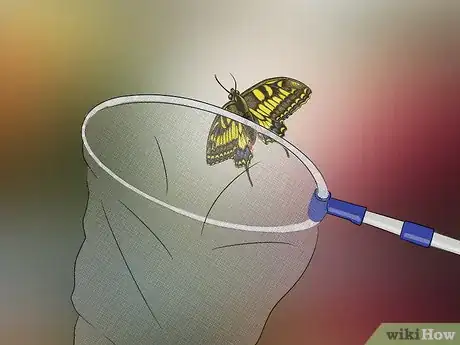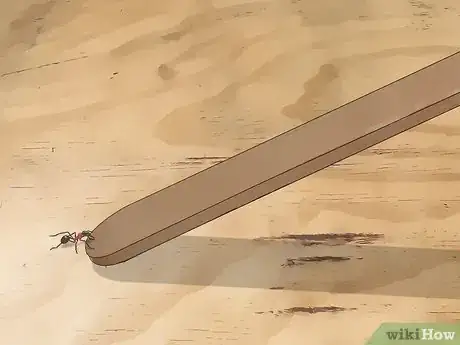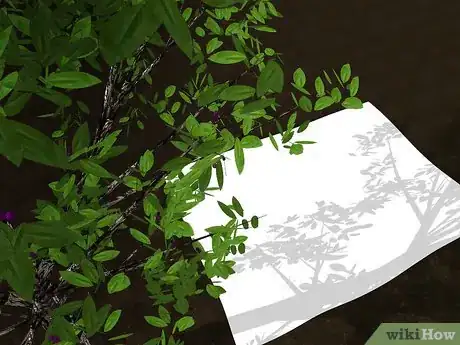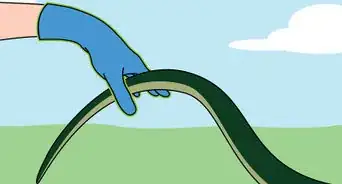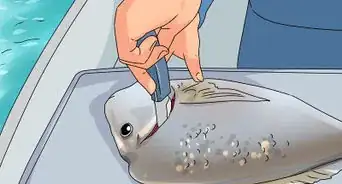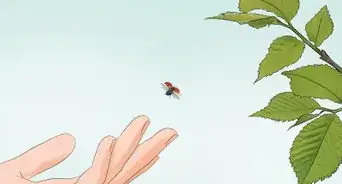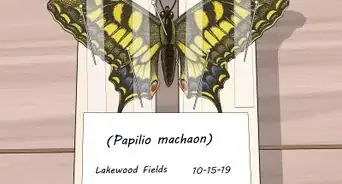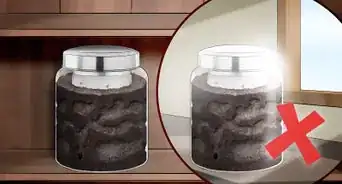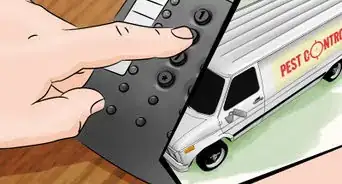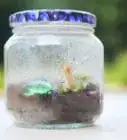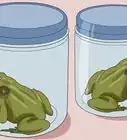This article was co-authored by Kevin Carrillo. Kevin Carrillo is a Pest Control Specialist and the Senior Project Manager for MMPC, a pest control service and certified Minority-owned Business Enterprise (MBE) based in the New York City area. MMPC is certified by the industry’s leading codes and practices, including the National Pest Management Association (NPMA), QualityPro, GreenPro, and The New York Pest Management Association (NYPMA). MMPC's work has been featured in CNN, NPR, and ABC News.
wikiHow marks an article as reader-approved once it receives enough positive feedback. In this case, several readers have written to tell us that this article was helpful to them, earning it our reader-approved status.
This article has been viewed 141,647 times.
Catching small bugs can seem like an exercise in futility. They are everywhere, but as soon as you try to focus on them they dart into impossible to reach corners or underground. Small bugs are everywhere, and if you know where to look and what basic traps to lay, you can grow your collection quickly.
Steps
Finding and Collecting Bugs By Hand
-
1Look under rocks and logs to uncover small insects of every kind. Bugs love dark, humid spots. Head to the nearest stream, or simply start turning over rotting logs, rocks, and other low-lying hiding spots. You can catch a large variety of insects this way as long as you're quick. In damp, loose soil, just dig 6-8" under the surface to reveal a plethora of insects.
- A net or garden shovel will make it much easier to get multiple insects at once.
- For delicate bugs, like mantises, consider using tweezers to keep them safe and intact while collecting.[1]
-
2Break apart rotting wood to search for termites and insect larva. The snug, relative protection of dead wood is a great place to go searching. While not necessary, gloves and long sleeves are generally recommended to protect your skin from splinters or nasty, moldy bits of wood. [2]
- Always treat your environment with respect. Breaking apart insect habitats should only be done if you need the bugs for research or survival, not purely for fun.
Advertisement -
3Snatch bugs out of the air with a net, though make sure you have the right one for the job. Flying insects, like ladybugs and moths, are tough to capture -- unless you have a net. If you're trying to save the bugs (such as for a collection), make sure that you have a net with a thin, light mesh, protecting valuable parts like wings and antennae.
- Sweep nets are solid, and are made for insects in bushes, trees, and long grass. You can use a pillowcase attached to a pole or branch to make your own.
- Butterfly nets are much thinner, and are only for aerial insects. If you want to make your own, purchase some light mesh from your local craft store.[3]
-
4Craft a stunning stick. If you don't have a net and aren't worried about keeping the insects in pristine condition, you can also use a stunning stick. Get a big stick with its large, leafy end still intact. Then, walking in tall grass, use the wide leaves and branches at the end to knock bugs out of the air, stunning them temporarily. Think of it as a large flyswatter. [4]
-
5Use a net, or even a kitchen colander, to harvest insects from streams. Slowly moving or stagnant water is a treasure trove for small insects. Using some sort of strainer, skim the top 1-2" of the water to pull out all sorts of mayflies, water skimmers, and even dragonflies.
- A net, especially one with a long reach, is almost always your best bet.
- In a pinch, such as a survival setting, you can make a net with two poles and a shirt. Tie the shirt between the sticks and sweep it across the water. Once you have something, bring the sticks together to circle the "net" around your prey.
-
6Catch ants with a simple stick and some patience. You'll want gloves for this, especially if you are unsure if the bugs bite. Simply jam a long stick into the mound and wait. As they panic at the intrusion, ants will climb up the stick in a frenzy. Once it is filled with as many as you want, pull the stick off and use your fingers to slide the ants into a bowl for safe keeping.
- Bright red ants are usually the most dangerous, so collect with caution.
Building Simple Traps
-
1Use the right bait to get the right insects. The following traps can all be improved by using bait. Most bait is simple sugar and yeast in the form of rotting fruit, sugar water, corn syrup, or alcohol. While most traps will get a few insects without it, insect bait will significantly improve your collection.
- Overripe fruit, fermented foods (like beer-soaked bread), peanut butter, and sugar will attract many insects.
- Rotten meat will attract carrion like maggots and flies.
- A mixture or fruit, rum or beer, and sugar will attract many nocturnal insects.
- Any kind of organic food will work to attract cockroaches.[5]
- If you're serious about collecting insects, you can buy pheromones online or in major garden stores to attract males insects.[6]
-
2Make a basic pitfall trap. Simple and effective. All you need is a plastic jar (like a peanut butter jar) or a soup can. Punch 4-5 holes in the bottom of your can. Dig up a hole the size of your can, then put the trap in so that the top of the can is even with ground level. Fill the trap with some dirt, leaves, and bait (optional), then wait for non-flying bugs to fall right in.[7]
-
3Make a funnel with an old plastic bottle to trap flying insects. A funnel trap requires little more than some scissors/knife and an old bottle. To make one, start with a soda bottle. While one liter is usually the easiest to work with, anything will do. Note, however, that this trap is not very effective in the rain. To make one:
- Cut the top of the bottle off, starting just where it begins to taper in towards the cap.
- Discard the cap, cutting off the small neck of the bottle.
- Turn the tapered end (that you just cut off) upside down and place it in the bottle, forming a funnel. Adhere with tape if needed.
- Place bait at the bottom of the trap and wait. Bugs fly into the funnel but use the walls to escape, making it impossible to leave again through the center hole.[8]
-
4Try a side-door type trap. This trap, though it seems simple, will capture a fair amount of insects, especially when used with bait. All it requires is a plastic bottle and a sharp knife:
- Cut a small "U" in the side of the bottle, with the uncut side nearest to the cap.
- Pull the flap upward, so that there is an opening in the bottle shielded by the "door."
- Place bait in the bottom of the bottle and wait. Most insects cannot find the door to get out, especially if you use sticky bait like sugar water or corn syrup.
- This trap is effective in the rain, as the door prevents water from getting in.[9]
-
5Make homemade sticky paper to catch flies and other small bugs. You can make your own flypaper with ease. Insects will be attracted to the sweet smell but unable to free themselves after landing. You can place the traps on the ground, though they are more effective when hung.
- Take an old paper bag or piece of cardboard and lightly wipe the surface clean.
- Mix equal parts sugar, water, and corn syrup on the stove until blended.
- Cool the sugar mixture for a few minutes.
- Spread the paste on the bag or cardboard to finish the trap.[10]
-
6Create a "beat sheet" to get lots of insects from bushes or small trees. The idea is simple -- you place a collection device (a pan, inverted umbrella, box, old sheet, etc.) under a tree or bush. Then you shake it. You can then collect the bugs that fall out with your hands or tweezers.[11]
- This works best on smaller trees, or locations you know that there are a lot of small, flightless bugs.
Warnings
- Always handle unknown bugs with care, and with gloves. While very few bugs are extremely poisonous, it is best to be cautious when working with insects.⧼thumbs_response⧽
Things You'll Need
- A small spade
- A jar
- Some bug bait
- 4 small, same sized stones
- A thin, square piece of wood
- Gloves
References
- ↑ http://www.fieldandstream.com/articles/survival/survival-food/2010/08/eating-insects-survival
- ↑ http://www.secretsofsurvival.com/survival/top-10-edible-insects.html
- ↑ https://www.uky.edu/Ag/Entomology/ythfacts/bugfun/collecti.htm
- ↑ http://www.survivalschool.us/eating-bugs-for-survival/
- ↑ Kevin Carrillo. Pest Control Specialist. Expert Interview. 22 October 2019.
- ↑ https://www.uky.edu/Ag/Entomology/ythfacts/bugfun/collecti.htm
- ↑ https://www.uky.edu/Ag/Entomology/ythfacts/bugfun/collecti.htm
- ↑ http://www.wisebread.com/pesky-pests-easy-homemade-mosquito-and-insect-traps-and-repellent
- ↑ http://www.wisebread.com/pesky-pests-easy-homemade-mosquito-and-insect-traps-and-repellent
About This Article
Small bugs can be difficult to catch, but you can make it easier with some simple, homemade traps. If you don’t know where to find small bugs, try looking underneath rocks or inside rotting wood, since many bugs live in dark places. You might also look on the surface of streams to find small water bugs. You can use a net or even a colander to catch water bugs. Just slowly move the net through the water until you catch one. For other types of bugs, try using a plastic jar with a piece of fruit for bait. Put the bait inside the jar, close the lid, then poke 4-5 holes in the bottom of the jar so bugs can get inside. Place it in the dirt and wait for them to crawl in! To learn how to catch butterflies, read on!


